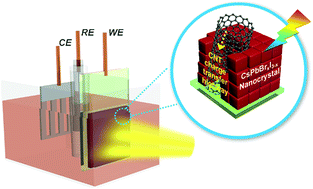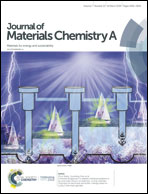Constructing CsPbBrxI3−x nanocrystal/carbon nanotube composites with improved charge transfer and light harvesting for enhanced photoelectrochemical activity†
Abstract
The past few years have witnessed an impressive development of all-inorganic halide perovskite nanocrystals. In this report, a series of CsPbBrxI3−x nanocrystal/carbon nanotube (CsPbBrxI3−x NC/CNT, x = 3, 2, 1.5, 1) hybrid photoelectrodes have been fabricated and further employed in photoelectrochemical cells. Benefiting from the high conductivity of CNTs, the hybrid samples show accelerated charge separation and transfer actions after photoexcitation. Moreover, increasing the I/Br ratio in CsPbBrxI3−x nanocrystals accounts for a wider adsorption range but inferior phase stability, which calls for a delicate balance. As a result, the highest photocurrent density of 420 μA cm−2 is finally achieved by CsPbBr1.5I1.5 NC/CNT (200), which corresponds to a 7.7-fold improvement over the prototype CsPbBr3. This report offers an in-depth understanding of the charge transfer behavior along with photoelectrochemical performance of CsPbBrxI3−x nanocrystal/CNT, which can surely stimulate metal halide perovskite nanocrystal-based hybrid materials for promising optoelectronic, photocatalysis and photoelectrochemical applications.



 Please wait while we load your content...
Please wait while we load your content...